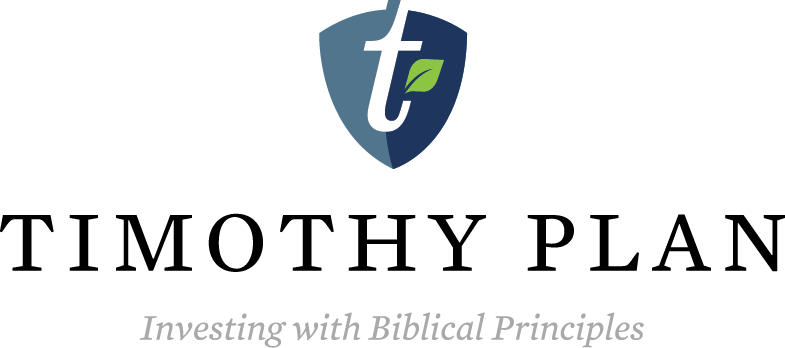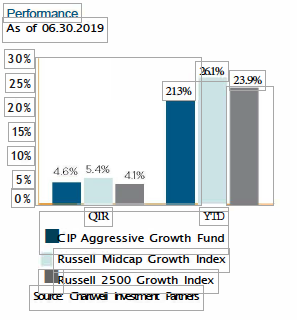Aggressive Growth 2Q19
July 30, 2019
Recent Posts
- A Businessman Who Really Did Give it All Over to GodSeptember 28, 2022
- A 'Screwtape' Approach to Keeping Christians from Biblically Responsible InvestingSeptember 21, 2022
- Both Inflation and Inaction Are UnbiblicalSeptember 14, 2022
- Misunderstood in the NeighborhoodAugust 18, 2022
- Billy Graham was the inspiration for the new BiblegraphAugust 9, 2022
- A Businessman Who Really Did Give it All Over to God
Categories

Investing involves risk, including the potential loss of principal.
Before investing, carefully consider the fund’s investment objectives, risks, charges, and expenses of the investment company. This and other important information can be found in the fund’s prospectus. To obtain a copy, visit TIMOTHYPLAN.COM or call 800.846.7526. Read each prospectus carefully before investing.
Because the Timothy Plan Funds do not invest in excluded securities, the Funds may be riskier than other funds that invest in a broader array of securities. There are risks when a fund limits its investments to particular sized companies, and all companies are subject to market risk. The Fund recently experienced significant negative short-term performance due to market volatility associated with the Covid-19 pandemic.
MUTUAL FUND INVESTOR
To read more about our mutual funds, please click this link to access fund information, including the prospectus, fact sheets, performance, and holdings for each fund.A prospectus is available from the Fund or your financial professional that contains more complete, important information. Please read it carefully before investing. Mutual Funds distributed by Timothy Partners, Ltd. Member FINRA.
HEADQUARTERS: 1055 Maitland Center Commons, Maitland, FL
(800) 846-7526 | Send an email | View our mapMUTUAL FUND SHAREHOLDER SERVICES: c/o Ultimus Fund Solutions, Post Office Box 541150, Omaha, NE 68154-1150
(800) 662-0201 | Account AccessETF INVESTOR
To read more about our ETFs, please click this link to access fund information, including fact sheets, performance and holdings for each fund. A prospectus is available from the Fund or your financial professional that contains more complete, important information. Please read it carefully before investing. ETFs distributed by Foreside Fund Services, LLC, Member FINRA. Timothy Partners, Ltd. is not affiliated with Foreside Fund Services, LLC.
ETF SHAREHOLDER SERVICES: Contact your financial advisor for information regarding your account.






Macroeconomic Update
On the supply side, businesses appear to have grown more cautious. Although both the June 2019 ISM Manufacturing and Non-Manufacturing (services) indices registered continuing expansion readings, botn metrics weakened as the quarter progressed The ISM Manufacturing index hit its lowest level since October 2016 and the ISM® Non-Manufacturing (services) index, which represents two-thirds of the domestic economy, fell to its lowest level in nearly two years Of concern, the New Order sub-component of the ISM Manufacturing index registered a reading of 50, which is the tipping point between expansion and contraction. This reading is the lowest level since December 2015. In contrast, on the demand side of the economy the negative impacts of tariffs are a bit more difficult to discern. While the University of Michigan Consumer Sentiment index trended down during the quarter, it remains elevated. Consumers remain on solid ground as employment gains remain at healthy levels overall. The quarterly average monthly employment gain of 170,000 during 02 2019, down from 180,000 during 01 and 233,000 in 04 of 2018, is indicative of slowing growth but wage gains and average hours worked remain generally steady It should be noted that the final round of proposed US tariffs on Chinese goods, which would have directly affected consumer products imports, has been postponed for the time being Future implementation would have a material impact on our outlook for consumer spending
While it appears that central banks in US, Europe, and China are prepared to adopt more accommodative monetary policies to support growth, the factors underlying the current slowdown, in our opinion, are not interest rate sensitive. As such, without a near-term resolution of the various trade disputes, we would expect economic activity to continue to weaken, with downside risk exceeding upside risk.
Q2 2019 Review
The markets continue to favor larger cap stocks over smaller cap names. Growth stocks are still trumping value names across all capitalizations as lower interest rates encourage investors to take another look at growth companies whose primary source of value lies out in the distant future. Financial Services stocks were strong in the mid cap growth space, while Energy names faltered as oil prices declined.
Aggressive Growth fell short of the Russell Mid Cap Growth Index by 085%, returning +4.55% versus the benchmark +54%. Sector allocation was mildly negative; the primary detraction from performance was stock selection in the Financial Services sector. Our best selection came within Health Care – here lnsulet (3 6%)7 returned +25%, Sarepta Therapeutics (1%) rose +27%, and Dentsply Sirona (12%) gained + 17.9%.
Contributors
lnsulet Corp (3 6%; +25 5%) develops, manufactures and markets the Omni Pod, an insulin infusion system for people with type 1 diabetes. There is a continued adoption of pumps and automated insulin delivery systems worldwide, particularly in the US. New patient growth in the US was mid 30% this quarter and the company is benefiting from wider Medicare and Medicaid coverage In the next few quarters, lnsulet will be providing updates on the launch of DASH, the company’s first new product in the past six years DASH offers users a new interface that allows the patient to control all settings through the patient’s smartphone device. This interface is a dramatic improvement over the current bulky controller.
HEICO (18%; +410%) is a well-run aerospace component manufacturer. It specializes in the aftermarket, offering airlines the ability to replace broken aerospace components at a sizable discount to the prices charged by the OEMs. Given that there is significant testing to receive approval by the FAA, there is a significant competitive ‘moat’ for this industry, limiting the number of competitors that HEICO faces.
Detractors
Nutanix (13%; -313%) is a leader in Hyperconverged Infrastructure (HCI), which streamlines the operations of datacenter services by combining and integrating software with hardware servers. This new technology is being rapidly adopted as more computing is being done in the cloud, which HCI is perfectly designed to address. Unfortunately, while Nutanix had a first mover advantage, it is facing intense competition from VMWare and Dell. Given the lower revenue visibility, the position has been sold from the portfolio.
Glu Mobile (13%; -34 3%) is a leading developer and publisher of freemium mobile games We were excited about the prospects of accelerating growth throughout this year, driven by WWE Universe and Disney’s Sorcerers Arena. However, we were very surprised to see that a core game, Design Homes, was facing much greater competition this year, that directly impacted bookings and revenues. And more importantly, game mechanics issues led the company to launch WWE Universe and then quickly pull the game from the market Given the poor execution from the management team, we have much lower confidence that Sorcerers Arena will be a success, and that led us to sell our position in Glu Mobile.
Market Outlook
In the second quarter, most of the “themes” in the market continued to play out in a directionally similar manner to 01 Both sides of the US/China tariff stand-off alternated between taking a hard stance and indicating that they thought a deal can get done. At the G20 meeting on the last weekend of the quarter, Trump and Xi agreed to delay pending tariff increases while negotiations continue. Many believe that it is optimistic to think that a deal will get done well before year-end The economic softness referred to in the “macro” section above has caused bond yields to take another leg down. The 10-year Treasury yield that dipped down to about 2.4% at the end of 01 went slightly below 2 0% in the 2nd quarter and finished at 2 0% on 6/30/19. The members of the Fed, for their part, had already indicated that they would be on hold for some time (sparking last quarter’s rally), but then in the June press conference they went further and hinted at a possible rate cut Chairman Powell said, “we will act as needed, including promptly if that’s appropriate” Market bulls think this return to a “Fed-put” scenario will keep at least a floor on the markets and that an eventual China deal will provide additional upside But with the market near recent highs and valuations above historical averages, arguably at least some of the positives are already discounted.
While we continue to be optimistic in our outlook, we acknowledge that there are several segments of the market that are becoming significantly overvalued. Specifically, within the Saas software universe, there are now several public companies that are trading at 10-20x forward sales, an unheard of valuation. Within the biotech sector, there are countless companies that have come public over the past year with only preclinical data, without any human clinical data to be analyzed All this reflects a market environment that perhaps has become overheated. It might be beneficial to see stocks which have had enormous returns over the past year consolidate those gains We continue to find compelling investment opportunities within the growth space and remain focused on generating alpha and producing the strongest investment results we can for you over the long run. We thank you for your continuing support and investment Please feel free to call or email us with any feedback or questions about the portfolio
The securities identified and described do not represent all of the securities purchased, sold or recommended for client accounts. The reader should not assume that an investment in the securities identified was or will be profitable. The Index returns are provided to show an example of alternate return potential during the relevant time periods; however, indices may possess different investment attributes that may make comparisons difficult such as volatility, liquidity, market capitalization, and security types. The statistical data regarding the indices has been obtained from Bloomberg and the returns are calculated assuming all dividends are reinvested. The indices are not subject to any of the fees or expenses to which the portfolios are subject. This report assumes the reader has sophisticated knowledge of investing and the markets. If you require more information about the information presented, including the portfolio characteristics and risk statistics, please contact us.
Manager views expressed herein were current as of the date indicated above and are subject to change. It should not be assumed that recommendations made in the future will be profitable or will equal the performance of the securities in this commentary. A copy of the calculation methodology and the full list of recommendations made in the preceding year is available upon request. The performance data quoted represents past performance and does not guarantee future results. Performance returns quoted are gross of fees which were calculated on a time weighted basis and do not give effect to investment advisory fees, which would reduce such returns. Please see Chartwell’s Form ADV, Part II for a complete description of investment advisory fees. The following statement demonstrates the compound effect advisory fees have on investment returns: For example, if a portfolio’s annual rate of return is 15% for 5 years and the annual advisory fee for a client is 100 basis points or 1.00%, the gross cumulative 5 year return would be 101.1% and the five year return net of fees would be 92.5%. Actual fees charged to portfolios may be different due to various conditions including account size, calculation method and frequency, and the presence of a performance or incentive fee. The deduction of performance and incentive based fees will have similar, yet often larger, impacts to performance and account values than standard management fees. To receive a complete list and description of Chartwell Investment Partners’ composites, performance attribution for all securities, and/or a presentation that adheres to the GIPS® standards, please contact Lynette Treible by phone (610)407-4870, email [email protected], or by mail to 1205 Westlakes Drive, Suite 100, Berwyn, PA 19312.